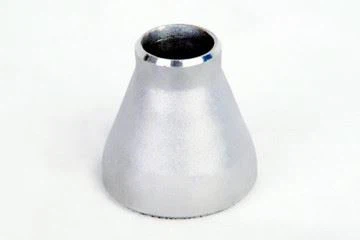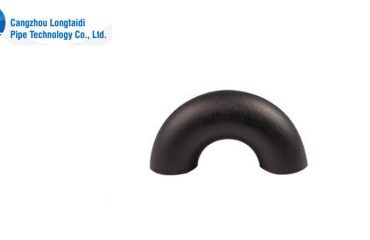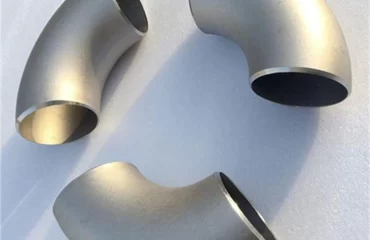
Dissecção aprofundada de graus específicos
WP304 e WP304H
WP304: Esta classe é o aço inoxidável mais amplamente utilizado, conhecido por sua versatilidade e equilíbrio de propriedades. Oferece excelente resistência à corrosão em ambientes atmosféricos e muitos meios corrosivos. Suas boas propriedades mecânicas e conformabilidade o tornam adequado para uma ampla gama de aplicações, desde equipamentos de cozinha até processamento químico.
WP304H: A versão de alto carbono do WP304, WP304H foi projetado para aplicações de alta temperatura. O aumento do teor de carbono aumenta sua resistência em temperaturas acima de 500°C (932° F). As aplicações comuns incluem componentes de caldeiras e trocadores de calor.
WP309
O aço inoxidável WP309 contém níveis mais elevados de cromo e níquel em comparação com o WP304, proporcionando resistência superior à oxidação. Esta classe é frequentemente usada em ambientes onde coexistem altas temperaturas e condições corrosivas, como peças de forno, oxidantes térmicos, e trocadores de calor.
WP310
WP310 é outra classe resistente a altas temperaturas, com teor de cromo e níquel ainda maior que o WP309. Mantém excelente resistência à oxidação e corrosão em ambientes de até 1100°C (2012° F). As aplicações típicas incluem componentes de forno, cestas de tratamento térmico, e equipamento de processamento químico.
WP316 e WP316L
WP316: A inclusão de molibdênio no WP316 aumenta sua resistência a corrosão de cloreto e fenda, tornando -o ideal para ambientes marítimos e químicos. É comumente usado em equipamentos farmacêuticos e de processamento de alimentos, bem como em aplicações de arquitetura costeira.
WP316L: A variante de baixo carbono do WP316 oferece maior soldabilidade e risco reduzido de precipitação de carboneto durante a soldagem. Isso o torna uma escolha preferida para aplicações soldadas em ambientes agressivos, como tanques químicos e sistemas de tubulação.
WP317L
WP317L Aço inoxidável contém maior conteúdo de molibdênio que Wp316, proporcionando uma resistência ainda melhor à corrosão de pitadas e fendas. É usado em ambientes altamente corrosivos, como processamento químico, petroquímica, e indústrias farmacêuticas.
WP321
Wp321 é estabilizado com titânio, que impede a formação de carbonetos de cromo a altas temperaturas, Melhorando assim sua resistência à corrosão intergranular. É adequado para aplicações envolvendo aquecimento contínuo e intermitente, como coletores de escape e componentes aeroespaciais.
WP347
Semelhante ao WP321, WP347 é estabilizado, Mas com Columbium (Nióbio). Esta nota oferece excelente resistência à corrosão intergranular e é comumente usada em aplicações de processamento químico e geração de energia de alta temperatura e geração de energia.
WP904L
WP904L é um aço inoxidável austenítico de alta liga com resistência excepcional à corrosão, especialmente contra ambientes de ácido sulfúrico e cloreto. Seu alto teor de níquel e molibdênio, junto com adições de cobre, Aumente sua resistência à corrosão de coroção e fenda. As aplicações típicas incluem dispositivos de resfriamento de água do mar, Processamento químico, e componentes de refinaria de petróleo.
Cenários de uso detalhados
Processamento químico
Na indústria química, a resistência a vários ácidos e cloretos é crucial. Classes como WP316, WP316L, WP317L, e WP904L são preferidos por sua resistência superior à corrosão. Esses materiais são usados em reatores, tanques de armazenamento, e sistemas de tubulação onde a exposição a produtos químicos agressivos é comum.
Indústria de petróleo e gás
O setor de petróleo e gás exige materiais que possam suportar altas pressões, temperaturas, e ambientes corrosivos. WP304H, WP309, WP310, e WP347 são frequentemente usados nesta indústria. Eles são encontrados em aplicações como componentes de refinaria, Oleodutos, e equipamentos de perfuração offshore.
Aplicações Marinhas
Ambientes marinhos são altamente corrosivos, especialmente devido à presença de cloretos. WP316, WP316L, e WP904L são ideais para tais condições. Eles são usados na construção naval, Estruturas Offshore, e usinas de dessalinização.
geração de energia
As usinas de energia exigem materiais que possam suportar altas temperaturas e pressões. WP321 e WP347 são adequados para essas aplicações devido à sua estabilidade e resistência à corrosão intergranular. Eles são usados em componentes de caldeiras, Trocadores De Calor, e peças de turbina.
Indústria de Alimentos e Bebidas
Saneamento e resistência à corrosão são fundamentais na indústria de alimentos e bebidas. WP304 e WP316 são comumente usados devido à sua não reatividade com substâncias alimentícias e facilidade de limpeza. As aplicações incluem equipamentos de processamento de alimentos, tanques de armazenamento, e tubulação.
Resumo
Os redutores de aço inoxidável em conformidade com os graus ASTM A403 WP oferecem uma ampla gama de propriedades adaptadas às necessidades industriais específicas. A seleção da classe apropriada depende de fatores como resistência à corrosão, resiliência à temperatura, Propriedades mecânicas, e soldabilidade. Compreender os benefícios e aplicações exclusivos de cada classe garante desempenho ideal e longevidade dos sistemas de tubulação em vários setores.
Referências
- ASTM A403/A403M: Especificação padrão para conexões de tubulação de aço inoxidável austenítico forjado.
- ASM Internacional: Manual de Aços Inoxidáveis.
- NACE Internacional: Noções básicas sobre corrosão: Uma introdução.
- Literatura Técnica: Propriedades de materiais e processos de fabricação para redutores de aço inoxidável.
- Relatórios de mercado: Tendências e previsões para a indústria do aço inoxidável.
Este documento abrangente deve fornecer uma compreensão completa dos redutores de aço inoxidável nas notas ASTM A403 WP, Orientar a seleção e aplicação desses materiais em vários contextos industriais.
Processos de fabricação detalhados
Para entender completamente as capacidades e limitações dos redutores de aço inoxidável ASTM A403 WP, É essencial investigar os processos de fabricação envolvidos. Esses processos influenciam muito as propriedades mecânicas, Microestrutura, e geral qualidade do produto final.
forjamento
forjamento é um método comum usado para fabricar redutores de aço inoxidável. Este processo envolve aquecer o aço a uma temperatura alta e depois moldá -lo usando forças compressivas. A forjamento melhora a estrutura de grãos, resultando em propriedades mecânicas aprimoradas, incluindo força e resistência.
- Forjamento de mordações abertas: Envolve deformar o metal entre múltiplas matrizes que não incluem completamente o material. É adequado para grande, formas personalizadas.
- Forjamento de morto fechado: Utiliza matrizes que incluem totalmente o material, permitindo formas precisas e consistentes. Este método é ideal para a produção de alto volume de redutores menores.
usinagem
usinagem é frequentemente empregado para alcançar as dimensões e tolerâncias finais necessárias para redutores de aço inoxidável. Este processo envolve a remoção de material de uma peça de trabalho usando ferramentas de corte.
- Virando: Usado para criar peças cilíndricas girando a peça de trabalho contra uma ferramenta de corte.
- Moagem: Envolve o uso de uma ferramenta de corte rotativa para remover o material e criar superfícies planas ou complexas.
- Perfuração e tapping: Essencial para criar orifícios e fios nos redutores.
tratamento térmico
tratamento térmico Os processos são cruciais para melhorar as propriedades mecânicas e a resistência à corrosão de redutores de aço inoxidável. Métodos comuns de tratamento térmico incluem:
- Recozimento: Envolve aquecer o aço a uma temperatura específica e depois resfriá -lo lentamente. Este processo alivia as tensões internas, melhora a ductilidade, e refina a microestrutura.
- Recozimento de Solução: Específico para aços inoxidáveis austeníticos, Este processo dissolve carbonetos precipitados, Aumentando a resistência à corrosão.
De soldagem
De soldagem é frequentemente necessário para unir os redutores de aço inoxidável a outros componentes em um sistema de tubulação. O processo de soldagem deve ser cuidadosamente controlado para evitar problemas como precipitação de carboneto, que pode comprometer a resistência à corrosão.
- TIG (Gás inerte de tungstênio) De soldagem: Oferece controle preciso e alta-qualidade soldas, tornando-o adequado para seções finas e aplicações críticas.
- MEU (Gás Inerte Metálico) De soldagem: Fornece velocidades de soldagem mais rápidas e é adequado para seções mais espessas.
Acabamento de Superfície
Acabamento de Superfície processos são essenciais para melhorar a aparência, Resistência à corrosão, e limpeza dos redutores de aço inoxidável.
- Decapagem e Passivação: Envolve a remoção de contaminantes superficiais e incrustações de óxido, seguido de passivação para restaurar a camada protetora de óxido de cromo.
- Eletropolimento: Um processo eletroquímico que suaviza e dá brilho à superfície, aumentando sua resistência à corrosão e reduzindo o risco de contaminação.
Controle de qualidade e testes
Garantindo o qualidade e o desempenho dos redutores de aço inoxidável é fundamental. Várias medidas de controle e controle de qualidade são implementadas ao longo do processo de fabricação.
Análise química
Análise química verifica a composição do aço inoxidável, garantir que atenda aos requisitos de nota especificada. Técnicas como espectroscopia de emissão óptica (OES) e fluorescência de raios-X (Xrf) são comumente usados.
Teste Mecânico
Teste Mecânico avalia a força, ductilidade, e resistência do material. Testes comuns incluem:
- Teste de tração: Measures the material’s response to tensile forces, providing data on yield strength, Resistência à tração, e alongamento.
- Teste de dureza: Determines the material’s resistance to indentation and wear.
- Teste de impacto: Evaluates the material’s toughness, particularly at low temperatures.
Teste não destrutivo (END)
Teste não destrutivo methods are used to detect surface and subsurface defects without damaging the material. Os métodos comuns de END incluem:
- Teste ultrassônico (OUT): Usa ondas sonoras de alta frequência para detectar falhas internas.
- Teste Radiográfico (RT): Employs X-rays or gamma rays to reveal internal defects.
- tingir teste de penetração (DPT): Used for detecting surface cracks and defects.
Inspeção dimensional
Inspeção dimensional ensures that the reducers meet the specified dimensions and tolerances. Techniques such as Coordinate Measuring Machines (Cmm) and calipers are commonly used.
Conclusão
The selection and application of ASTM A403 WP stainless steel reducers require a thorough understanding of the various grades, their properties, and the manufacturing processes involved. By considering factors such as corrosion resistance, Propriedades mecânicas, and specific application requirements, industries can ensure optimal performance and longevity of their piping systems.
Referências
- ASTM A403/A403M: Especificação padrão para conexões de tubulação de aço inoxidável austenítico forjado.
- ASM Internacional: Manual de Aços Inoxidáveis.
- NACE Internacional: Noções básicas sobre corrosão: Uma introdução.
- Literatura Técnica: Propriedades de materiais e processos de fabricação para redutores de aço inoxidável.
- Relatórios de mercado: Tendências e previsões para a indústria do aço inoxidável.
This comprehensive guide should provide valuable insights into the intricate world of stainless steel reducers, aiding in the selection, Aplicação, and quality assurance of these critical components in various industries.



Você deve ser logado postar um comentário.